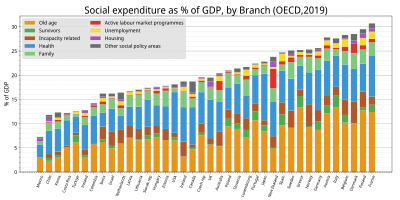
A welfare state is a form of government in which the state (or a well-established network of social institutions) protects and promotes the economic and social well-being of its citizens, based upon the principles of equal opportunity, equitable distribution of wealth, and public responsibility for citizens unable to avail themselves of the minimal provisions for a good life.[1]
There is substantial variability in the form and trajectory of the welfare state across countries and regions.[2] All welfare states entail some degree of private–public partnerships wherein the administration and delivery of at least some welfare programs occur through private entities.[3] Welfare state services are also provided at varying territorial levels of government.[3]
Early features of the welfare state, such as public pensions and social insurance, developed from the 1880s onwards in industrializing Western countries.[4][2][5] World War I, the Great Depression, and World War II have been characterized as important events that ushered in the expansion of the welfare state.[4][6] The fullest forms of the welfare state were developed after World War II.[2]
- ^ "Welfare state". Britannica Online Encyclopedia. 18 November 2023.
- ^ a b c Béland, Daniel; Morgan, Kimberly J.; Obinger, Herbert; Pierson, Christopher (2021), Béland, Daniel; Leibfried, Stephan; Morgan, Kimberly J.; Obinger, Herbert (eds.), "Introduction", The Oxford Handbook of the Welfare State, Oxford University Press, pp. xxx–20, doi:10.1093/oxfordhb/9780198828389.013.1, ISBN 978-0-19-882838-9
- ^ a b Béland, Daniel; Morgan, Kimberly J. (2021), Béland, Daniel; Leibfried, Stephan; Morgan, Kimberly J.; Obinger, Herbert (eds.), "Governance", The Oxford Handbook of the Welfare State, Oxford University Press, pp. 172–187, doi:10.1093/oxfordhb/9780198828389.013.10, ISBN 978-0-19-882838-9
- ^ a b Skocpol, Theda (1992). Protecting Soldiers and Mothers. Harvard University Press. ISBN 9780674717664. Retrieved 21 March 2020.
- ^ Koehler-Derrick, Gabriel; Lee, Melissa M. (2023). "War and Welfare in Colonial Algeria". International Organization. 77 (2): 263–293. doi:10.1017/S0020818322000376. ISSN 0020-8183. S2CID 256724058.
- ^ O'Hara, Phillip Anthony, ed. (1999). "Welfare state". Encyclopedia of Political Economy. Routledge. p. 1247. ISBN 978-0-415-24187-8.
The welfare state emerged in the twentieth century as one institutional form of this socially protective response. In the 1930s, the responses of emerging welfare states to the Great Depression were to the immediate circumstances of massive unemployment, lost output, and collapse of the financial and trading systems. Planning was not a key element in the response to the crisis of capitalism. Instead the character of welfare state intervention can best be described as an 'interventionist drift', reflecting the spontaneous, uncoordinated reactions of the protective response...By the late 1970s, the welfare state and the capitalist economic structure in which it was placed were in a general state of crisis. There had never been a well articulated vision or ideological foundation of the welfare state.